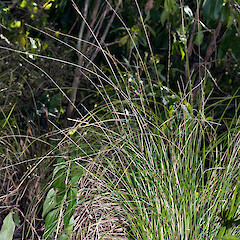Carex erythrovaginata
Common name
lax bastard grass, hook sedge
Synonyms
Uncinia laxiflora Petrie
Family
Cyperaceae
Flora category
Vascular – Native
Endemic taxon
Yes
Endemic genus
No
Endemic family
No
Structural class
Sedges
NVS code
The National Vegetation Survey (NVS) Databank is a physical archive and electronic databank containing records of over 94,000 vegetation survey plots - including data from over 19,000 permanent plots. NVS maintains a standard set of species code abbreviations that correspond to standard scientific plant names from the Ngä Tipu o Aotearoa - New Zealand Plants database.
UNCLAX
Chromosome number
2n = 88
Current conservation status
The conservation status of all known New Zealand vascular plant taxa at the rank of species and below were reassessed in 2017 using the New Zealand Threat Classification System (NZTCS) – more information about this can be found on the NZTCS website. This report includes a statistical summary and brief notes on changes since 2012 and replaces all previous NZTCS lists for vascular plants.
Please note, threat classifications are often suggested by authors when publications fall between NZTCS assessment periods – an interim threat classification status has not been assessed by the NZTCS panel.
- Conservation status of New Zealand indigenous vascular plants, 2017 . 2018. Peter J. de Lange, Jeremy R. Rolfe, John W. Barkla, Shannel P. Courtney, Paul D. Champion, Leon R. Perrie, Sarah M. Beadel, Kerry A. Ford, Ilse Breitwieser, Ines Schönberger, Rowan Hindmarsh-Walls, Peter B. Heenan and Kate Ladley. Department of Conservation. Source: NZTCS and licensed by DOC for reuse under the Creative Commons Attribution 4.0 International licence.
2017 | Not Threatened
Previous conservation statuses
2012 | Not Threatened
2009 | Not Threatened
2004 | Not Threatened
Distribution
Endemic. New Zealand: North and South Islands (as far south as Dunedin).
Habitat
Coastal to montane. Usually in forest, rarely in scrub.
Detailed description
Stout, densely caespitose-tufted, dark green plants. Culms 400–750 × 0.5–1.0 mm, trigonous, strongly scabrid above; basal bracts dull reddish brown. Leaves 3–6 per culm, < or = culm, 2–3 mm wide, strongly scabrid on margins and upper surface; sheath and basal part of lamina usually reddish pink. Spike 60–100 mm long, female flowers c. 10, lax, internodes > mature utricles, 5–14 mm long at base of spike, 2 mm long above; spike often bracteate with lowermost glume leaf-like or setose. Glumes much < utricles, persistent, coriaceous obtuse or lowermost subacute, green with paler margins. Utricles 5–8 × c. 1 mm, plano-convex or biconvex, fusiform, very faintly nerved, cuneate below forming a stipe c. 1.5 mm long and tapered above to a beak c. 2 mm long stipe and beak green, remainder very light grey.
Similar taxa
A very distinctive species easily recognised by the stout, leafy tussock-forming habit, narrow, dark green, flat leaves with strongly scabrid upper leaf surfaces. It is perhaps most similar to Carex strictissima (Petrie) K.A.Ford with which it has on occasion been confused. From that species it differs by its obviously leafy, rather than rush-like growth habit and by having 3–6 rather than 1-6, ± flat rather than mostly involute leaves which are 2–3 mm wide rather than c. 1 mm. Furthermore the inflorescences are rather lax rather than stiffly erect.
Flowering
October–November
Fruiting
November–January (-March)
Propagation technique
Easily grown from fresh seed and by division of established plants. Prefers a permanently moist, peaty soil but will grow in most substrates. Best in semi-shade.
Etymology
carex: Latin name for a species of sedge, now applied to the whole group.
Where To Buy
Not Commercially Available
Attribution
Fact sheet prepared for NZPCN by Peter J. de Lange 17 August 2006. Description adapted from Moore and Edgar (1970).
References and further reading
Moore LB, Edgar E. 1970. Flora of New Zealand, Volume II. Indigenous Tracheophyta: Monocotyledones except Gramineae. Government Printer, Wellington, NZ. 354 p.
NZPCN Fact Sheet citation
Please cite as: de Lange, P.J. (Year at time of access): Carex erythrovaginata Fact Sheet (content continuously updated). New Zealand Plant Conservation Network. https://www.nzpcn.org.nz/flora/species/carex-erythrovaginata/ (Date website was queried)





